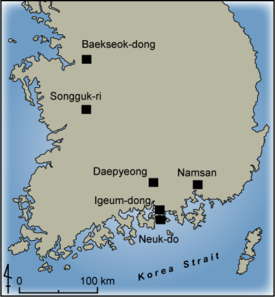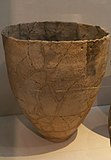
The Neolithic or New Stone Age is an archaeological period, the final division of the Stone Age in Europe, Asia, Mesopotamia and Africa. It saw the Neolithic Revolution, a wide-ranging set of developments that appear to have arisen independently in several parts of the world. This "Neolithic package" included the introduction of farming, domestication of animals, and change from a hunter-gatherer lifestyle to one of settlement. The term 'Neolithic' was coined by Sir John Lubbock in 1865 as a refinement of the three-age system.
The 1490s BC was a decade lasting from January 1, 1499 BC to December 31, 1490 BC.

The Yayoi period started in the late Neolithic period in Japan, continued through the Bronze Age, and towards its end crossed into the Iron Age.

The Geum River is a major river of South Korea that originates in Jangsu-eup, North Jeolla Province. It flows northward through North Jeolla and North Chungcheong Provinces and then changes direction in the vicinity of Greater Daejeon and flows southwest through South Chungcheong Province before emptying into the Yellow Sea near Gunsan city.

A megalith is a large stone that has been used to construct a prehistoric structure or monument, either alone or together with other stones. There are over 35,000 structures or arrangements in Europe alone, located widely from Sweden to the Mediterranean sea.

Gobeunok or Gogok are comma-shaped or curved beads and jewels that appeared from middle age of Mumun Period through the Three Kingdoms of Korea. The Gogok is posited by researchers to have been a symbol of prestige among Mumun culture community leaders as the tombs of presumably powerful figures were oftentimes accompanied by bronze daggers, stone daggers, and comma-shaped jewels. The Gogok's role as a symbol of prestige would carry onto the Three Kingdoms Period of Korea (as Gogok would remain a salient feature of Korean royal paraphernalia. They range in size range from 1 to 10 centimetres, and are oftentimes fashioned with a hole to be attached or threaded to another object. The origin of these comma-shaped jewels are posited by some to originate from the dragon-shaped jadeite ornament of the Hongshan culture of the Liao River Basin. However, due to the spatial and temporal distance, most researchers have been skeptical of their genealogical relationship. The generally accepted interpretation in academia is that the form of the comma-shaped jewel originated from the canine teeth of predator animals such as the Magatama of Japan from the late Jōmon period or as a symbol of a half-moon sacred to moon worshippers, or as a symbol of fetus and or fertility.

A paddy field is a flooded field of arable land used for growing semiaquatic crops, most notably rice and taro. It originates from the Neolithic rice-farming cultures of the Yangtze River basin in southern China, associated with pre-Austronesian and Hmong-Mien cultures. It was spread in prehistoric times by the expansion of Austronesian peoples to Island Southeast Asia, Madagascar, Melanesia, Micronesia, and Polynesia. The technology was also acquired by other cultures in mainland Asia for rice farming, spreading to East Asia, Mainland Southeast Asia, and South Asia.

The Peninsular Japonic languages are now-extinct Japonic languages reflected in ancient placenames and glosses from central and southern parts of the Korean Peninsula. Most linguists believe that Japonic arrived in the Japanese archipelago from the Korean peninsula during the first millennium BCE. The placename evidence suggests that Japonic languages were still spoken in parts of the peninsula for several centuries before being replaced by the spread of Korean.

The state of Jin was a confederacy of statelets which occupied some portion of the southern Korean peninsula from the 4th to 2nd centuries BCE, bordering the Korean Kingdom of Gojoseon to the north. Its capital was somewhere south of the Han River. It preceded the Samhan confederacies, each of which claimed to be the successor of the Jin state.
The year 1975 in archaeology involved some significant events.

The Yayoi people were an ancient people that immigrated to the Japanese archipelago during the Yayoi period and are characterized through Yayoi material culture. Some argue for an earlier start of the Yayoi period, between 1000 and 800 BC, but this date is controversial. The people of the Yayoi culture are regarded as the spreaders of agriculture and the Japonic languages throughout the whole archipelago, and were characterized by both local Jōmon hunter-gatherer and mainland Asian migrant ancestry.
The classification of the Japonic languages and their external relations is unclear. Linguists traditionally consider the Japonic languages to belong to an independent family; indeed, until the classification of Ryukyuan and eventually Hachijō as separate languages within a Japonic family rather than as dialects of Japanese, Japanese was considered a language isolate.

Igeum-dong is a complex archaeological site located in Igeum-dong, Samcheonpo in Sacheon-si, South Gyeongsang Province, South Korea. This prehistoric archaeological site is important in Korean prehistory because it represents solid evidence that simple chiefdoms formed in as early as the Middle Mumun, some 950 years before the first state-level societies formed in Korea. The settlement is dated by pottery, pit-house types, and an AMS radiocarbon date to the Late Middle Mumun Pottery Period. Test excavations were conducted in 1997, and wide-scope horizontal excavations took place in 1998 and 1999.

Daepyeong is a complex prehistoric archaeological site located in the Nam River valley near Jinju in South Gyeongsang Province, South Korea. Pottery typologies and seriations and a host of AMS radiocarbon dates show that the site had a number of occupations over several millennia from c. 3500 BC - AD 500.

Yoshinogari is the name of a large and complex Yayoi archaeological site in Yoshinogari and Kanzaki in Saga Prefecture, Kyūshū, Japan. According to the Yayoi chronology established by pottery seriations in the 20th century, Yoshinogari dates to between the 3rd century BC and the 3rd century AD. However, recent attempts to use absolute dating methods such as AMS radiocarbon dating have shown that the earliest Yayoi component of Yoshinogari dates to before 400 BC.

Songguk-ri is a Middle and Late Mumun-period archaeological site in Buyeo-gun, Chungcheongnam-do, South Korea. Songguk-ri is a settlement and burial site that is important in the study of Korean prehistory. It is registered as Historical Site No. 249. Songguk-ri is a main point of reference in Korean prehistory—Korean archaeologists have represented the prehistoric village and the material culture excavated from there as the type-site for Middle Mumun Culture in southern Korea.

Prehistoric Korea is the era of human existence in the Korean Peninsula for which written records do not exist. It nonetheless constitutes the greatest segment of the Korean past and is the major object of study in the disciplines of archaeology, geology, and palaeontology.
Brahmagiri is an archaeological site located in the Chitradurga district of the state of Karnataka, India. Legend has it that this is the site where sage Gautama Maharishi and his wife Ahalya lived. He was one among seven noted Hindu saints. This site was first explored by Benjamin L. Rice in 1891, who discovered rock edicts of Emperor Ashoka here. These rock edicts indicated that the locality was termed as Isila and denoted the southernmost extent of the Mauryan empire. The Brahmagiri site is a granite outcrop elevated about 180 m. above the surrounding plains and measures around 500 m east-west and 100 m north-south. It is well known for the large number of megalithic monuments that have been found here. The earliest settlement found here has been dated to at least the 2nd millennium BC.

The Jeulmun pottery period is an archaeological era in Korean prehistory broadly spanning the period of 8000–1500 BC. This period subsumes the Mesolithic and Neolithic cultural stages in Korea, lasting ca. 8000–3500 BC and 3500–1500 BC, respectively. Because of the early presence of pottery, the entire period has also been subsumed under a broad label of "Korean Neolithic".

In Japanese history, the Jōmon period is the time between c. 14,000 and 300 BC, during which Japan was inhabited by a diverse hunter-gatherer and early agriculturalist population united through a common Jōmon culture, which reached a considerable degree of sedentism and cultural complexity. The name "cord-marked" was first applied by the American zoologist and orientalist Edward S. Morse, who discovered sherds of pottery in 1877 and subsequently translated "straw-rope pattern" into Japanese as Jōmon. The pottery style characteristic of the first phases of Jōmon culture was decorated by impressing cords into the surface of wet clay and is generally accepted to be among the oldest in the world.

































